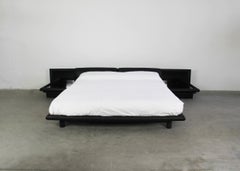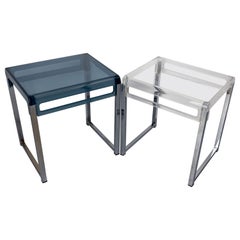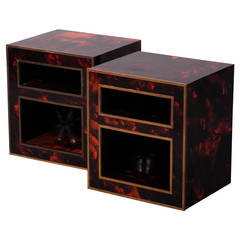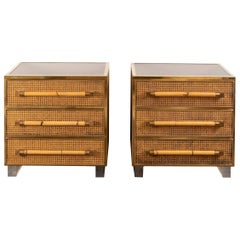Plexi Nightstand
Tobia and Afra Scarpa Morna Bed with Nightstands by Molteni 1972
By Afra & Tobia Scarpa, Molteni & C
Located in Montecatini Terme, IT
Tobia and Afra Scarpa Morna bed with nightstand in wood, black padded leather, and plexiglass
Category
Vintage 1970s Italian Mid-Century Modern Beds and Bed Frames
Materials
Steel
$13,038
H 22.05 in W 127.96 in D 90.56 in
French Pair of Polycarbonate & Chrome Coffee Table or Nightstand Table, c. 1980
Located in Labrit, Landes
when they are joined or nightstands.
They also can be easily stored if you have a little space.
Made
Category
Late 20th Century French Mid-Century Modern Coffee and Cocktail Tables
Materials
Chrome
$580 / set
H 16.15 in W 14.97 in D 12.6 in
Recent Sales
Pair of Italian Plexiglas Nightstands
Located in grand Lancy, CH
pair of Italian plexiglas nightstand
Category
Vintage 1970s Italian Night Stands
Pair of Small Commodes / Large Nightstands by Sandro Petti
By Metalarte, Sandro Petti
Located in Paris, Ile-de-France
Pair of small commodes / large nightstands designed by Sandro Petti, manufactured by Metalarte.
3
Category
Vintage 1970s Italian Mid-Century Modern Commodes and Chests of Drawers
Materials
Brass
Jean Claude Mahey Nightstands, France, 1970
By Jean Claude Mahey
Located in Roosendaal, Noord Brabant
quality nightstands are made of brown Plexiglas, and are finished with a brass edge. Identical cabinets
Category
Vintage 1970s French Mid-Century Modern Bedroom Sets
Materials
Brass
Tobia and Afra Scarpa Morna Bed with Nightstands by Molteni 1972
By Afra & Tobia Scarpa, Molteni & C
Located in Montecatini Terme, IT
Tobia and Afra Scarpa Morna bed with nightstand in wood, black padded leather and plexiglass
Category
Vintage 1970s Italian Mid-Century Modern Beds and Bed Frames
Materials
Steel
Rare Pair of Nightstands Designed by Gilbert Rohde
Located in San Francisco, CA
A beautiful pair of nightstands designed by Gilbert Rohde for Herman Miller, circa 1939. Made of
Category
American Night Stands
Materials
Brass
People Also Browsed
Modern Oval Coffee Table in Oak Wood Cylinder Base and Glass by Ercole Home
By Ercole Home
Located in Brooklyn, NY
Palazzo oval coffee table with green and ivory glass sits on 2 Rift White Oak Wood pedestals by Ercole Home. This new bespoke coffee table design by Ercole Home is available today fo...
Category
21st Century and Contemporary American Modern Coffee and Cocktail Tables
Materials
Art Glass, Cut Glass, Walnut
$6,500 / item
H 14 in W 36 in D 20 in
A Pair of Art Deco Easy Chairs in Green Velour, Swedish Cabinetmaker, 1940s
Located in Odense, DK
This pair of lounge chairs in green velour showcases the remarkable craftsmanship of a Swedish cabinetmaker during the Art Deco period in the 1940s. These chairs have an air of elega...
Category
Mid-20th Century Swedish Scandinavian Modern Lounge Chairs
Materials
Fabric, Velvet, Birch
$6,800 / set
H 27.96 in W 29.14 in D 31.5 in
Pair of Cerused Oak Nightstands
By Paul Laszlo
Located in Rockaway, NJ
Pair of American Mid-Century Modern cerused oak nightstands.
Category
20th Century American Mid-Century Modern End Tables
Pair of Park Night Stands in Espresso Brown Lacquer by Yaniv Chen for Lemon
By Lemon
Located in Amsterdam, NL
The Park nightstand is the epitome of exquisite craftsmanship, featuring meticulously proportioned dimensions and exceptional detailing that make it an ideal bedside companion. Our f...
Category
2010s South African Minimalist Pedestals
Materials
Lacquer
$4,836 Sale Price / set
20% Off
H 24.01 in W 18.12 in D 14.18 in
Robsjohn-Gibbings for Widdicomb Mid Century Mesa Coffee Table
By T.H. Robsjohn-Gibbings, Widdicomb Furniture Co.
Located in Franklin Park, IL
Robsjohn-Gibbings for Widdicomb Mid Century Mesa Coffee Table
This coffee table measures: 74 wide x 50 deep x 17 inches high
All pieces of furniture can be had in what we call rest...
Category
Vintage 1970s American Mid-Century Modern Coffee and Cocktail Tables
Materials
Wood
Gianni Moscatelli desk for Formanova 70’s.
By Formanova, Gianni Moscatelli
Located in bari, IT
Desk design by Gianni Moscatelli for Formanova 1970s. Palisander desk surface rests on flat stainless steel legs with floating drawers on either side. Original locks without keys.
Category
Vintage 1970s Italian Mid-Century Modern Desks and Writing Tables
Materials
Stainless Steel
Pair of Bamboo and Glass Tables
By Ficks Reed
Located in New York, NY
Chic pair of cube form bamboo stands with plate glass tops. Each table has cross hatch woven sides and open ends, both are in good condition, clean, sturdy, and ready to use. One gla...
Category
Mid-20th Century Philippine Mid-Century Modern End Tables
Materials
Bamboo, Glass
Hans-Agne Jakobsson 'Mini-Tratten' Darkly Patinated Outdoor Sconce
By Örsjö Industri AB, Hans-Agne Jakobsson
Located in Glendale, CA
Hans-Agne Jakobsson 'Mini-Tratten' darkly patinated outdoor sconce. An exclusive made for U.S. and UL listed authorized re-edition of the classic Swedish design executed in rich dark...
Category
21st Century and Contemporary Swedish Scandinavian Modern Wall Lights an...
Materials
Metal
$1,696 Sale Price / item
20% Off
H 4.15 in W 5.35 in D 7.75 in
Angelo Lelii for Arredoluce Chandelier in Hammered Brass
By Angelo Lelii, Arredoluce
Located in Waalwijk, NL
Angelo Lelii for Arredoluce, chandelier model 12369, brass, Italy, design circa 1951
Organic chandelier by Angelo Lelii designed for Arredoluce. Six leaves open towards the ceiling ...
Category
Vintage 1950s Italian Mid-Century Modern Chandeliers and Pendants
Materials
Brass
Signed Original Mid-Century Modern Carrara Marble Coffee Table by Knoll
By Knoll
Located in Los Angeles, CA
Original Vintage Condition
Materials: Italian Marble, Chrome Metal
Category
Vintage 1950s American Mid-Century Modern Coffee and Cocktail Tables
Materials
Marble, Chrome
$995
H 19 in W 29.5 in D 29.5 in
Max Sauze Isosceles Tables
By Max Sauze
Located in Las Vegas, NV
Pair of Max Sauze Isosceles tables for Arrow, France 1970s. Black metal wire-frame with glass inserts. Striking minimalist design works with any decor.
Category
Vintage 1970s French Post-Modern End Tables
Materials
Metal
Pair of Mid-Century Modern White Laminate Nightstands
Located in Brooklyn, NY
This beautiful vintage modern pair of end tables feature one drawer and a large compartment underneath. Sleek design with ample room for storage and a large top to set items. The hea...
Category
Vintage 1970s Mid-Century Modern End Tables
Materials
Chrome
$600 Sale Price / set
50% Off
H 24.5 in W 20 in D 20 in
Percival Lafer MP‑41 Lounge Chair & Ottoman, Brazil, 1970s – Green Leather
By Percival Lafer
Located in Oslo, 03
This rare MP-41 lounge chair with matching ottoman was designed by Percival Lafer for Móveis Lafer, Brazil, in the early 1960s. It is part of Lafer’s celebrated MP series, known for ...
Category
Vintage 1960s Brazilian Mid-Century Modern Lounge Chairs
Materials
Leather
$7,349
H 37.41 in W 35.44 in D 35.44 in
Midcentury Chrome Coffee Table
Located in Brooklyn, NY
Round glass top coffee table with polished base made of chrome rings.
(Please confirm item location - NY or NJ - with dealer).
Category
Vintage 1960s Mid-Century Modern Coffee and Cocktail Tables
Materials
Chrome
Jacques Adnet Sofa
Located in San Francisco, CA
A Jacques Adnet sofa restored with mohair upholstery and leather piping.
Category
Vintage 1930s French Modern Sofas
Materials
Mahogany
Side Table, 1960s
Located in Ljubljana, SI
Vintage side table
Period: 1960s
Material: wood, formica
Colour: Clear, dark red
Condition: good original vintage condition, signs of use
dimensions: Height = 58cm, di...
Category
Vintage 1960s Slovenian Mid-Century Modern Side Tables
Materials
Hardwood
Get Updated with New Arrivals
Save "Plexi Nightstand", and we’ll notify you when there are new listings in this category.
Read More
39 Incredible Swimming Pools
It's hard to resist the allure of a beautiful pool. So, go ahead and daydream about whiling away your summer in paradise.
May’s Most Popular Interiors on Instagram
Our feed is filled with the world's most beautiful spaces. See the rooms our followers have deemed the best of the best this month.
More Ways To Browse
Bedroom Furniture By Molteni
Murano Snail
Musical Figurines
Mythological Figurines
Nao Figurines
Nao Porcelain
Napoleon Crossing The Alps
Napoleonic Bone
Napoleonic Soldier
Narcisse Vase
Naruko Kokeshi Doll
Nason Fish
Native American Art Horses
Native American Bow
Navy Bell
Nelson And Nelson Antiques
Nelson Omni Wall Unit
Neo Classicism Style



